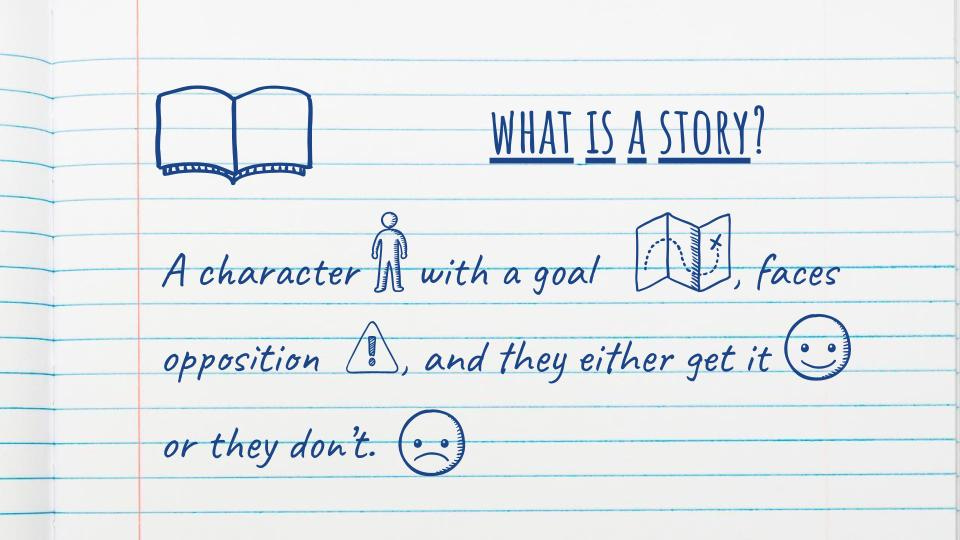As I predicted in my film cycles video,1 video game adaptations are becoming more prevalent, especially in terms of box office success. For the last few years, video game movies have made more money (on average) per film than superhero comic book movies.2
The recent release of Until Dawn3 got me thinking about some intriguing aspects of character and story, how they function differently in the two art forms, and what happens when one is adapted (or, as we'll see, re-mediated) into the other.
The topic turned out to be way more complicated than I realized, and so to lay the proper groundwork, this became a three-part essay. Parts two and three are available to paying subscribers now, and will be unlocked for free subscribers over the next few days.
Radical Identification
At the most basic level, every story is a character with a goal, who faces opposition to that goal, and either succeeds or fails in some definite way.
Everything else—character arcs, story structure, theme—is built on top of this basic framework. None of those other things are strictly necessary. Consider the world’s shortest story, supposedly written by Hemingway:
FOR SALE
Baby shoes
Never worn
In the simplest short stories, you don’t have to know anything about the protagonist, other than their goal. Heck, it’s possible to make a (short) film where you don’t even see the protagonist—
In a work of greater length and complexity, writers typically create a protagonist the audience can identify (if not necessarily sympathize) with. The protagonist ought to be understandable, even if they’re not justified in the end, or else the audience will become disengaged.
Video games are different. They induce a strangely intense form of identification with the protagonist, even in the most simplistic of games. You don't say, "Mario fell down the hole;" you say, "I fell down the hole."
Even someone watching you play a game mostly identifies the player avatar as the player and not a separate character: “You fell off the horse.”
But are we exactly “identifying” with Mario? He’s barely even a character. The early NES games are a fever dream of multi-colored turtles, talking mushroom people, and manically smiling, giant bullets. “Mario wants to rescue the princess, fights Bowser, and succeeds in the end” is technically a story by the definition given above, but only barely. We identify with Mario insofar as our goal aligns with his.
But what of more advanced games, with complex narratives and three dimensional (in both senses of the word) characters?
Skill Issue
A character is defined by their choices. Video games are an interactive medium, so you’d think the player would identify with the character even more through in-game choices. But when a game’s story becomes more complicated and defined, many game designers resort to cut scenes4 to advance the plot. As the on-screen character makes choices independent of the player, a kind of bifurcation occurs.
Take Arkham City (still one of the best Batman stories in any medium). One could watch only the cutscenes and mostly grasp the story.5 The game is “interactive,” but most of the “choices” the player makes boil down to the order in which they face Batman’s rogues' gallery. Moment-to-moment decisions (such as what bat-gadget to use or which asylee to violently assault first) are really more about gameplay strategy and skill, rather than character development.
Spec Ops: The Line famously deconstructed this gameplay/story segregation, by highlighting the dissonance and making the player question their own real-life decisions.6
You really only have two options—play or don’t.
So, a video game can be pure gameplay, like Tetris. Or, a game can alternate between gameplay and more traditional narrative modes, like cinema in the Arkham series or prose in Myst. But some game makers have tried to create games where your gameplay choices actually do affect character and story.
Such is the case with Until Dawn.
Choose Your Own
Until Dawn plays like a slasher movie version of a Choose Your Own Adventure book. You mostly watch cutscenes, or walk around from room to room until another cutscene begins. At certain points, you’ll be given a binary choice between certain actions. Described coldly like that, it sounds boring, but it’s actually quite fun.
The characters are a mélange of horror movie tropes (the jock, the nerd, etc). But within the range of these stereotypes, their emotional states and relationships are heavily affected by the conscious choices you, the player, make, as well as by your skill reacting to quick time events.
With very clear and deep roots in a classic film genre, you’d think it would be easy to adapt Until Dawn into movie. In fact, the process of adaptation was so complicated the filmmakers threw out the game’s story entirely.
The reason? You’ll have to read Part 2 of this essay to find that out.
Sadly under-viewed, in my humble opinion. You should watch it!
Hollywood is still currently making more superhero movies, so the totals are higher. That’s why I compared the per-film average.
Don’t worry, there won’t be any spoilers for either the game or the movie Until Dawn. (Although judging by the box office results, not many people are all that interested in seeing that particular film anyway.)
A term I hate, because it seems to stem from a misunderstanding of the film term “cut.”
Some people have created “movies” of the game, and the majority of the footage is, indeed, from the cutscenes.










